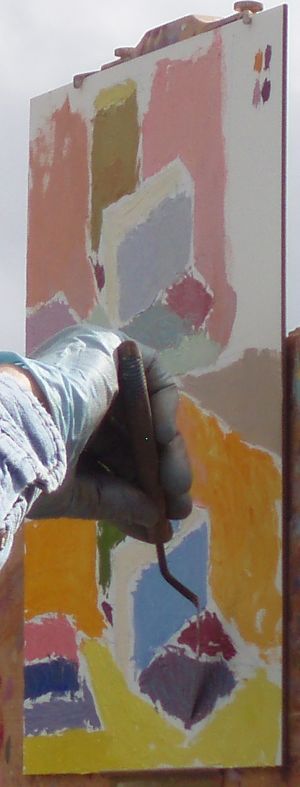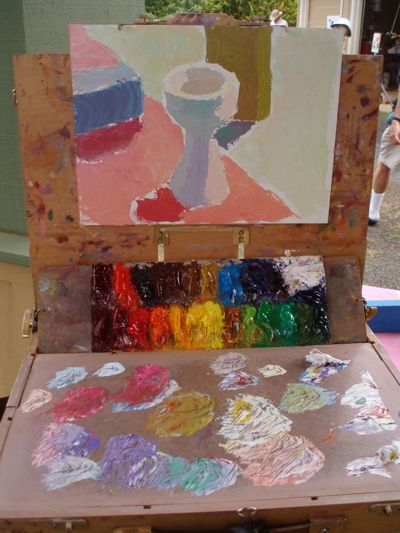 The first day of Camille’s class, we followed her “Color Boot Camp”, which involves painting colored blocks in natural sunlight, after the technique she learned from Henry Henche.
The first day of Camille’s class, we followed her “Color Boot Camp”, which involves painting colored blocks in natural sunlight, after the technique she learned from Henry Henche.
These exercises allow you to clearly see color relationships. Each block is painted a different color (in light and shade), as well as two different colored table cloth. This technique is similar to the “color separation” technique I’ve written about before here. When you think about it, none of the colors in these studies should repeat, after all, they’re all separate colors. The same is true in nature, it’s extremely rare to see two things that are not the same the same color–especially when you introduce distance, space and air. Have trouble simplifying outdoors? I know I do. This simplies things greatly, so you can really focus and study on color.
We experienced mixed sun and shade during the day, so as the sun came and went, she moved between the overcast day study (above) and the full sun study (below).
A palette knife is used to you’re forced to not get too detailed, keep the colors clean and solid. You keep working each relationship paint over paint, constantly adjustmenting, keeping the light and shadow planes very clearly separated.
This is a great exercise to judge color and value relationships that is transferable to the field. Tomorrow, we’re going to in effect paint a “block”, but this time a building in a park.
Here’s another study, this featuring a rounded object:

I did paint a seascape after class, but it’s too dark to photograph (I like to photograph in natural light, in the shade). I’ll post tomorrow. ‘Til then!
Aloha from 5 inches of snow last night Chicago!
I painted with a friend who also took Camille’s workshop.
I notice he to, put his fresh paint on a second palette.
Is there any other purpose other than having more room to mix?
I usually paint on thin-plexiglass painted gray on the backside.
When I get home if I have a lot of paint left or want to continue
another day, I pop it into a Masterson “tupperware like” box
and put it into the freezer. It seems to hold a long time.
I do the same by pop-ing my plein air into a second box.
If I want to put a little more time into the piece, both the paint
and the painting are soft in minutes.
I have never heard-of, or suffered from any quality loss from doing
this.
Thanks for the site, nice job, Tom
I recognise this technique and am trying to remember which of my books I read about it in – but Lois Griffel is the name in my head as I look at this – also a student of Henry Hensche!